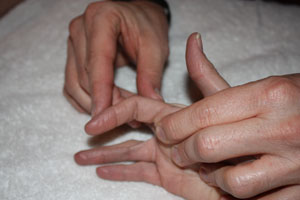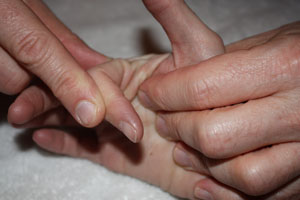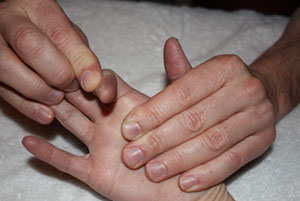Bunnell-Littler Test: Difference between revisions
Jon DeVaul (talk | contribs) No edit summary |
Jon DeVaul (talk | contribs) No edit summary |
||
| Line 1: | Line 1: | ||
<div class="editorbox"> | <div class="editorbox"> | ||
'''Original Editor '''- | '''Original Editor '''- Jon DeVaul[[Physiopedia:Editors|, PT, DPT<br>]] | ||
</div> | </div> | ||
== Purpose<br> == | == Purpose<br> == | ||
This test evaluates the source of PIP flexion motion limitation by differentiating between intrinsic muscle or capsular tightness in the affected digit. A typical patient presentation may include pain located in the distal intermetacarpal space and with prolonged gripping or making a fist. Symptoms are most often seen in the ring and long finger.<ref name="text">Donatelli RA, Wooden MJ editors:Orthopaedic Physical Therapy, ed 4, St Louis, 2010, Churchill Livingston.</ref><br> | This test evaluates the source of PIP flexion motion limitation by differentiating between intrinsic muscle or capsular tightness in the affected digit. A typical patient presentation may include pain located in the distal intermetacarpal space and with prolonged gripping or making a fist. Symptoms are most often seen in the ring and long finger.<ref name="text">Donatelli RA, Wooden MJ editors:Orthopaedic Physical Therapy, ed 4, St Louis, 2010, Churchill Livingston.</ref><br> | ||
== Technique<br> == | == Technique<br> == | ||
| Line 16: | Line 16: | ||
<br> | <br> | ||
[[Image:B l end capsular.jpg|no increase in PIP flexion with MCP flexion implies capsular restriction]] [[Image:B l normal.jpg|full PIP flexion with MCP extension is a normal (-) test finding]] | [[Image:B l end capsular.jpg|no increase in PIP flexion with MCP flexion implies capsular restriction]] [[Image:B l normal.jpg|full PIP flexion with MCP extension is a normal (-) test finding]] | ||
== Evidence == | == Evidence == | ||
While referred to in many searched texts and articles, no search of Pubmed, Medline, or Medscape produced results pertaining to the specificity or sensitivity of this test by the name Bunnell-Littler, or the associated name Finochietto-Bunnell test. <br> | While referred to in many searched texts and articles, no search of Pubmed, Medline, or Medscape produced results pertaining to the specificity or sensitivity of this test by the name Bunnell-Littler, or the associated name Finochietto-Bunnell test. <br> | ||
== Resources == | == Resources == | ||
Orthopaedic Physical Therapy by Donatelli and Wooden. 4th edition. | Orthopaedic Physical Therapy by Donatelli and Wooden. 4th edition. | ||
Special Tests for Orthopedic Examination by Konin, Wiksten, Isear, and Brader. 2nd edition. | Special Tests for Orthopedic Examination by Konin, Wiksten, Isear, and Brader. 2nd edition. | ||
== References == | == References == | ||
<br> | |||
<references /> | <br> <references /> | ||
[[Category:Articles]] [[Category:Assessment]] [[Category:EIM_Student_Project_2]] [[Category:Hand]] [[Category:Musculoskeletal/Orthopaedics]] [[Category:Special_Tests]] | [[Category:Articles]] [[Category:Assessment]] [[Category:EIM_Student_Project_2]] [[Category:Hand]] [[Category:Musculoskeletal/Orthopaedics]] [[Category:Special_Tests]] | ||
Revision as of 04:36, 8 December 2009
Original Editor - Jon DeVaul, PT, DPT
Purpose
[edit | edit source]
This test evaluates the source of PIP flexion motion limitation by differentiating between intrinsic muscle or capsular tightness in the affected digit. A typical patient presentation may include pain located in the distal intermetacarpal space and with prolonged gripping or making a fist. Symptoms are most often seen in the ring and long finger.[1]
Technique
[edit | edit source]
The MCP is held in an extended position and the therapist passively flexes the PIP making note of the available range. The test is then repeated with the MCP flexed. If no change in motion is detected between the two tests, then capsular restriction at the PIP joint is implicated. If the motion increases when the MCP is flexed, then lumbricale muscle tightness is implicated.[2]
Scroll over the pictures below for captions.
Evidence[edit | edit source]
While referred to in many searched texts and articles, no search of Pubmed, Medline, or Medscape produced results pertaining to the specificity or sensitivity of this test by the name Bunnell-Littler, or the associated name Finochietto-Bunnell test.
Resources[edit | edit source]
Orthopaedic Physical Therapy by Donatelli and Wooden. 4th edition.
Special Tests for Orthopedic Examination by Konin, Wiksten, Isear, and Brader. 2nd edition.
References[edit | edit source]










